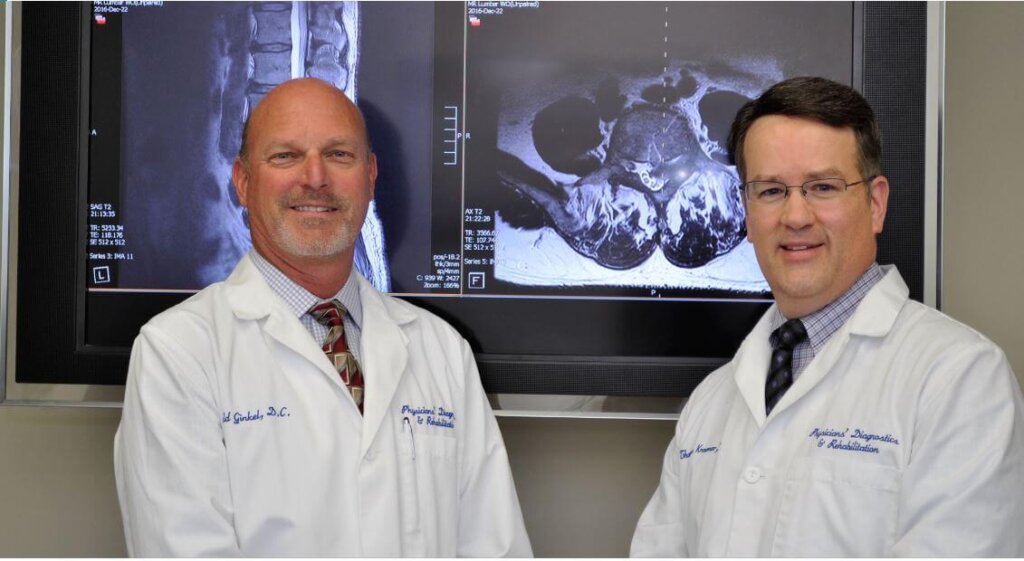The specially trained physicians and therapists at Physicians’ Diagnostics & Rehabilitation Clinics (PDR) are providing patients with relief from neck and back pain through nonsurgical treatment with proven and measurable results. The cornerstone of that treatment is the MedX Lumbar and Cervical Extension Machines.
PDR utilizes MedX machines to help people get better by isolating and strengthening damaged muscles of the neck and lower back. MedX machines have been used in treatment for more than 30 years and have been the subject of more than 75 university-based studies documenting their success in improving strength, endurance and range of motion, and in reducing pain.
The clinic provides aggressive rehabilitation for patients with acute to chronic pain, with a focus on chronic pain resulting from soft tissue injuries to the neck and back. PDR’s founder, Todd Ginkel, DC explained that soft tissue injuries occur when the muscles, ligaments and fascia are rapidly stretched beyond their physiological limits causing tearing, bleeding, adhesions and scar tissue. “This results in crosshatch fibers as it relates to muscle tissue, which restrict range of motion and strength. In rehab, we aggressively exercise damaged tissue to break up adhesions, reorganize collagen structures and regain normal motor patterns.”
Another thing that happens when a person gets injured is an in-growth of pain fibers. “Tissue that is not normally a pain generator is now pain sensitive,” said PDR’s medical director, Thomas Kramer, MD. “The muscles lose strength, range of motion, and now are sensitized. Through our treatment, we isolate those, test to get an objective measure, and then rebuild that muscle tissue to align it closer to normal function.”
Since there is no way to image muscle with this level of detail, many injured patients have normal MRIs. “But we can objectively measure the injury using the MedX machines,” Kraemer said. “We restrain muscles we don’t want to work while isolating very specific muscles that have atrophied and stopped working. Then we jump-start those muscles and work to get them back up to speed. It’s objective. We start by testing to compare a patient’s range of motion, strength and endurance with the norm for somebody of their same age, weight and gender. We hope to get them back to those norms. If we can’t, we can objectively measure that, as well, and report the extent of dysfunction.”
Many of PDR’s patients are referred from other physicians and are suffering from chronic pain arising from an accident or injury. “Chronic pain is anything more than three months,” Ginkel said. “We typically don’t see a patient right aft er an accident, but a few months aft er because they didn’t recover right up front. We see a full range of cases from nonsurgical to post-surgical. We hope to catch patients before surgery and help them avoid more invasive treatment.”
Treatment at PDR is medically supervised. Candidates are first evaluated by a physician to make a diagnosis and to ensure they are suitable for treatment. MedX machines are operated by highly trained therapists, and care is monitored by physi- cians who continue to see the patient every few weeks to evaluate their progress.
There is a definite beginning and end to treatment. PDR empowers patients to take control of their lives and self-manage their activity and pain. Ginkel stated, “We know when they’ve reached their maximum improvement and recovery. Our goal is to teach a home exercise program they can continue on their own, and if they want to transition to their health club or fitness classes, we will assist in developing a program that works for them.”
Patients typically participate in a total of 16 to 24 twice-weekly visits at one of PDR’s five clinic locations before they are discharged from the program. When asked to rate their recovery on a scale of 10, most report their recovery at 7.5. Patients also experience a 50 to 100 percent reduction in pain meds by the end of the cycle.
PDR provides active patient care, and they work with people who have decided they want to get better. That’s a big plus for a representing attorney. Kraemer explained, “By going through our program, a person is demonstrating that they are serious about wanting to get better. They’re not just getting treatment and running up bills. At all times, we are moving a person to be able to self-manage their condition. We don’t want to build dependency on treatment.”
PDR also addresses a patient’s emotional response to living with pain through cognitive behavioral coaching. When someone has been in pain for months, it is normal for them to become focused on their pain and to begin limiting their physical activities. These maladaptive thought patterns become automatic. Cognitive behavioral therapy helps patients to understand that while they may still have some pain, they can confidently return to work or activities they enjoy without fear that their body will fail.
The professionals at PDR recognize that one of the greatest frustrations for patients and attorneys is the coordination of care. They are proficient at working with other medical providers to help patients get whatever additional care they need. PDR is an approved provider for most major insurance carriers and health plans including most workers’ compensation, auto and personal injury insurance plans. They are also available for phone consultations with attorneys and will provide written reports and expert testimony.
By means of this active and objective method of care, patients discover for themselves that they can build strength, reduce or eliminate pain, self-manage their condition and return to everyday activities. That confidence makes them convincing witnesses at trial. Attorneys go to trial equipped with reports that both objectively measure the extent of their client’s injury and graph the residual injury.
“People come to us because they get better,” Kraemer said. “We want people to know that they may still have some pain, but they can go back to doing what they want and love to do without worsening their condition.”







